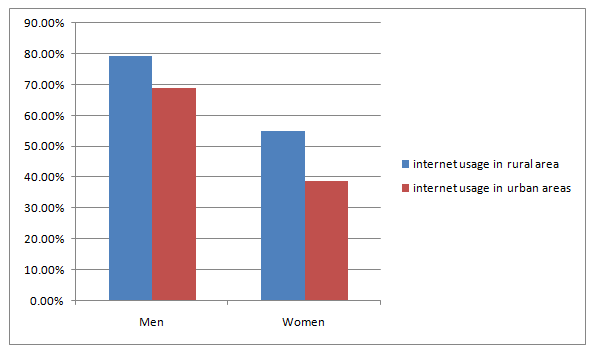BRIDGING THE GAP: UNDERSTANDING THE DIGITAL GENDER DIVIDE IN JAMMU AND KASHMIR UNION TERRITORY
Abstract
Digitalization is a crucial element in contemporary societies, playing a key role in achieving sustainable development goals and deeply embedding itself in our social, political, and economic lives. The versatile benefits of digital technology touch various aspects, empowering entrepreneurs, facilitating citizen engagement, aiding migrant remittances, improving accessibility to telemedicine, supporting flexible work arrangements, and enhancing educational experiences. However, the transformative potential of digitalization is not equally accessible, especially for women and girls facing barriers rooted in social, cultural norms, and gender stereotypes.
Jammu and Kashmir, the northernmost union territory of India, grapples with a literacy rate of 67.16%, notably lower than the national average of 77.7% (NFHS, 2022). The COVID-19 pandemic worsened challenges in the region exposing gaps in technology availability and proficiency, emphasizing the need for robust digital infrastructure. Unfortunately, ICT facilities in J&K are costly, limited, and unevenly distributed. Adding to these challenges is the pervasive gendered digital divide, hindering girls in the UT of J&K from fully embracing digital technologies.
This research paper aims to scrutinize digital device accessibility, assess the gender gap in device usage among women in the UT of J&K, and explore challenges faced by women in adopting digital technology. The study also seeks to highlight digital initiatives by the federal government, state governments, and the Government of J&K to address the gender digital gap. Additionally, it strives to provide practical recommendations for bridging this gap and promoting digital inclusivity in the UT of J&K.
Keywords: Digitalization, ICT Infrastructures, Gender Digital Divide, Digital technology.
Downloads
References
ASER: Annual Status of Education Report. (2021, November 17). https://asercentre.org/aser-2021/
Das, N. (2022). India’s UPI Far Advanced than Similar System in Use in Developed Nations, Outlook. https://www.outlookindia.com/business/india-s-upi-far-advanced-than-similar-system-in-use-in-developed-nationssays-report-news-196701. vkb/Data-Center
de Haan, J. (2004). A multifaceted dynamic model of the digital divide. IT & Society, 1(7), 66–88.
Gender Digital Divide Index Report. (2022). DAKA advisory and WinDt Consulting. https://gddindex.com/wp-content/uploads/2022/02/GDDI-Report-2022.pdf
Gender inequality and the digital divide in India. (2023, July 1). The Times of India. https://timesofindia.indiatimes.com/top-headlines/gender-inequality-and-the-digital-divide-in-india/articleshow/101409556.cms
Gulati, P. (2022, December). Digital Divide: India Inequality Report 2022. People’s Archive of Rural India. https://ruralindiaonline.org/en/library/resource/digital-divide-india-inequality-report
Intel and Dalberg (2012), Women and the Web. Bridging the Internet and Creating New Global Opportunities in Low and Middle Income Countries, Intel Corporation and Dalberg Global DevelopmentAdvisors, https://www.intel.com/content/dam/www/public/us/en/documents/pdf/women-andtheweb.pdf .
ITU.(2022).Facts and Figures 2022 - The gender digital divide. (2022, November 24). https://www.itu.int/itu-d/reports/statistics/2022/11/24/ff22-the-gender-digital-divide/
Kalra, M. (2023, April 8). Dear India Inc., Here’s How Digital Gender Divide Is Holding Back Women. BQ Prime. https://www.bqprime.com/opinion/dear-india-inc-heres-how-digital-gender-divide-is-holding-back-women
Mushtaq, D. T. (2020). The Gender Digital Divide: An Exploratory Research Of University Of Kashmir. Academia.edu. https://www.academia.edu/42970847/The_Gender_Digital_Divide_An_Exploratory_Research_Of_University_Of_Kashmir
NSS 75th round schedule-25.0. (July 2017-June 2018). India - Household Social Consumption: Health, (2022b, May 9). https://microdata.gov.in/nada43/index.php/catalog/152
National Family Health Survey.(2022).National Family Health Survey (NFHS-5). https://rchiips.org/nfhs/factsheet_NFHS-5.shtml
OECD (2018), Bridging the Digital Gender Divide – Include, Upskill, Innovate, http://www.oecd.org/internet/bridging-the-digital-gender-divide.pdf.
Oxfam India(OIN). (2022, December 5). India Inequality Report 2022: Digital Divide |https://www.oxfamindia.org/knowledgehub/workingpaper/india-inequality-report-2022-digital-divide
Steele, C. (2019, February 23). What is the Digital Divide? Digital Divide Council. http://www.digitaldividecouncil.com/what-is-the-digital-divide/
The Mobile Gender Gap Report 2021. Investing in Women. (2021, July 7). https://investinginwomen.asia/knowledge/mobile-gender-gap-report-2021/
UNESCO.(2023). Digital divide | (2023,). https://www.unesco.org/en/tags/digital-divide
UNICEF. (2023.) 90 per cent of adolescent girls and young women in low-income countries are offline.https://www.unicef.org/press-releases/90-cent-adolescent-girls-and-young-women-low-income-countries-are-offline-unicef
United Nations in India Annual Report 2022. India. (2023,). https://india.un.org/en/247832-united-nations-india-annual-report-2022
United Nations Statistics Division. (2022). The Gender Snapshot 2022 — SDG Indicators. https://unstats.un.org/sdgs/gender-snapshot/2022/
United Nations. (2022). UN E-Government Knowledgebase. (2022) fhttps://publicadministration.un.org/ ego
van Dijk, J. (2006). Digital divide research, achievements and shortcomings. Poetics, 34(4–5), 221–235.
Wojnar & Kanishka Agiwal, A. M. (2023, March 21). The stage has been set for gender equity in Digital India. Mint. https://www.livemint.com/opinion/columns/the-stage-has-been-set-for-gender-equity-in-digital-india-11679423093491.html

Copyright (c) 2024 Kavita Suri, Sonali Sharma

This work is licensed under a Creative Commons Attribution 4.0 International License.














